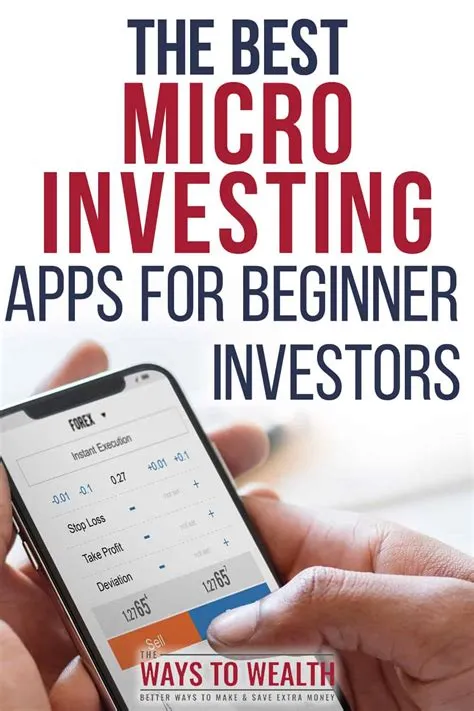Hey there, future financial whiz! Ever felt like investing is only for the super-rich, a world of jargon and complicated spreadsheets? Think again! micro-investing-risks">micro-investing-platforms">micro-investing-basics">micro-investing is changing the game, making it easier than ever to start building your wealth, even if you only have a few dollars to spare. Think of it as planting tiny seeds that grow into a mighty financial forest. And guess what? Amazing apps are here to guide you through this exciting journey.
This article is your personal roadmap to navigate the world of micro-investing apps, specifically designed for beginners like you. We’ll explore the top contenders, comparing their features, benefits, and ease of use. By the end, you’ll be equipped to choose the perfect app to kickstart your investing adventure. Ready to dive in? Let’s get started!
What is Micro-Investing, Anyway?
Before we jump into specific apps, let’s clarify what micro-investing is all about. It’s simply investing small amounts of money regularly, often as little as $1 or even less. Imagine it as a daily savings plan, but instead of putting money in a traditional savings account, you’re investing it in stocks, ETFs (exchange-traded funds), or other assets. This approach takes away the intimidation factor of needing a large sum to start investing. It’s like building a LEGO castle; you start with one brick, then another, and soon you have a magnificent structure.
Why Choose Micro-Investing?
So, why bother with micro-investing? Here are a few compelling reasons:
Accessibility: It lowers the barrier to entry significantly. Anyone can participate, regardless of their income level.
Habit Formation: Regular, small contributions help build a disciplined savings habit. It’s about consistency, not huge amounts.
Compounding Power: Even small investments grow over time thanks to the magic of compounding interest. This is where your money makes money, accelerating your growth. Think of it as a snowball rolling downhill – it gets bigger and bigger as it goes!
Diversification: Many micro-investing apps allow for diversification across various asset classes, reducing risk. Don’t put all your eggs in one basket, right?
Flexibility: You can adjust your contributions as needed, making it easy to adapt to changing circumstances.
Top Micro-Investing Apps for Beginners:
Now, let’s get to the heart of the matter – the apps themselves. Choosing the right one depends on your specific needs and preferences, but here are some popular and user-friendly options:
Acorns: Acorns is known for its simplicity and user-friendly interface. It uses “round-ups,” automatically investing your spare change from purchases. It’s like getting a tiny investment bonus with every purchase. This is perfect for those who want to start investing effortlessly. However, Acorns does have fees, so it’s important to factor that in.
Stash: Stash caters to beginners with its educational resources and simple investment options. They offer fractional-shares-basics">fractional-shares-and-wealth-building">fractional-share-platforms">fractional shares, allowing you to invest in companies even if their share price is high. You can start investing with a relatively small amount. However, Stash also has fees associated with its services.
Robinhood: Robinhood is a popular choice for its commission-free trading. This means you keep more of your money working for you. While it offers a broader range of investments than some micro-investing apps, it’s important to note that it can feel overwhelming for complete beginners due to its more comprehensive features.
Betterment: Betterment is a robo-advisor, which means it uses algorithms to manage your investments based on your risk tolerance and goals. This is a great option for those who want a more hands-off approach. However, robo-advisors typically have higher fees compared to some of the other apps listed.
Choosing the Right App: A Personal Journey
Choosing the right app is a bit like choosing a pair of shoes; you need to find the perfect fit. Consider these factors:
Fees: Compare the fees charged by each app, as these can eat into your returns over time.
Investment Options: Consider the range of investment options available, such as stocks, ETFs, and bonds.
User Interface: Choose an app with a clean, intuitive interface that is easy to navigate.
Educational Resources: Look for apps that offer educational resources to help you learn more about investing.
Customer Support: Consider the availability and responsiveness of customer support.
Beyond the Apps: Building Your Financial Fitness
Remember, the best micro-investing app is only part of the equation. Financial success is a marathon, not a sprint. Here are some additional tips for your journey:
Set Realistic Goals: Define your financial goals, whether it’s retirement, a down payment on a house, or something else entirely.
Diversify Your Portfolio: Don’t put all your eggs in one basket. Spread your investments across different asset classes to reduce risk.
Stay Informed: Keep learning about investing. There are tons of free resources available online and in libraries.
Be Patient: Investing is a long-term game. Don’t get discouraged by short-term market fluctuations.
Review Regularly: Check your investment portfolio regularly, but avoid making impulsive decisions based on short-term market movements.
Conclusion:
Micro-investing apps offer a fantastic way to start your investing journey, even with limited funds. By carefully considering the apps discussed, and by following sound investment principles, you can lay the foundation for a secure financial future. Remember, the key is consistency and patience. Start small, learn as you go, and watch your financial garden grow!
FAQs:
1. Are micro-investing apps safe? Reputable apps are regulated and use security measures to protect your investments. However, it’s crucial to choose established apps with a strong track record.
2. Can I withdraw my money at any time? Most apps allow withdrawals, but there might be limitations or fees depending on the app and your investment choices.
3. What if the market crashes? Market downturns are a normal part of investing. A long-term perspective and diversification can help mitigate losses.
4. How much money do I need to start? Many apps let you start with just a few dollars, making it accessible to everyone.
5. What if I don’t understand investing? Most micro-investing apps offer educational resources and simple investment options to help beginners. Don’t be afraid to take advantage of these resources!

